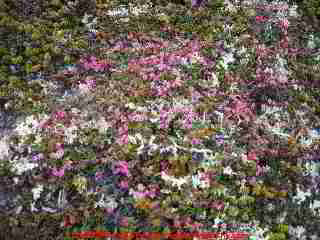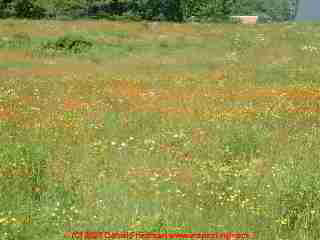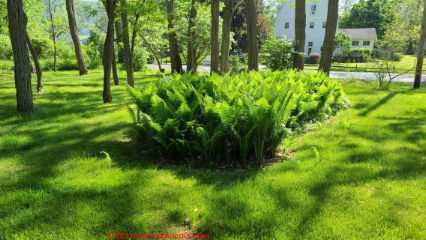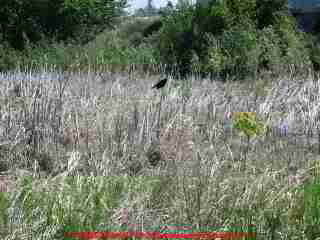 Planting Ground Coverings Over Septic System Components
Planting Ground Coverings Over Septic System Components
an illustrated guide
- POST a QUESTION or COMMENT about what ground covers can be planted over septic drainfields or mounds
Ground covers that can be planted over septic fields:
This septic system design and maintenance article discusses the types of plants that should or should not be planted over or near septic fields or other septic system components.
Planting trees, shrubs, and even some ground covers over septic system components are causes of septic system failure in the drain field, leach field, seepage bed, or similar components.
InspectAPedia tolerates no conflicts of interest. We have no relationship with advertisers, products, or services discussed at this website.
- Daniel Friedman, Publisher/Editor/Author - See WHO ARE WE?
Planting Ground Cover Over Septic Fields
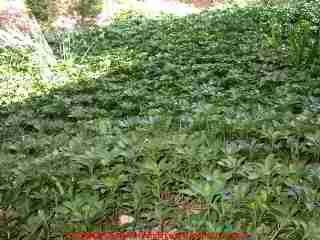 There are several problems that can be caused by planting the wrong thing on top of or too close to septic system drainfields or soakaway beds.
There are several problems that can be caused by planting the wrong thing on top of or too close to septic system drainfields or soakaway beds.
Among these we are concerned with
- Possible sewage pathogens that may enter and contaminate edible fruits or vegetables grown on or too close to septic fields
Planting fruit trees, or vegetables (or anything else edible) over the septic drainfield might produce food that is unsafe to eat:
see SEWAGE CONTAMINANTS in FRUIT / VEGETABLES for details.
- Invasive roots of plants too close to the septic system can invade and clog system piping, leading to costly septic field repairs.
But here we address an additional, less well known but equally important problem:
- Blocked soil transpiration - some plantings can interfere with moisture evaporation from the soil below - transpiration: the movement of septic effluent moisture from the soil into the air by evaporation.
Transpiration is an important ingredient in wastewater disposal in many septic system designs.
What Kinds of Ground Cover Should Not Be Planted over Septic Systems?
Avoid planting invasive rooted, deep-rooted or large heavy plants over the drainfield or where they would interfere with septic tank maintenance.
Avoid planting projects that would require driving or even heavy foot or animal traffic over septic mounds and raised-bed septics.
Details of what to avoid over the septic soakaway
The photographs above show pachysandra as a dense ground cover (at left) and typical ground cover north of the arctic circle in Norway (at right).
Thick dense vegetation of any sort will conserve moisture to itself and will prevent soil transpiration.
- Planting so dense that it will interfere with soil moisture evaporation / transpiration (one of the steps in disposing of septic effluent).
Over a septic system this means that the portion of effluent disposal that is supposed to be occurring due to evaporation will be reduced and the liquid load on surrounding soils increased - you've cut the effectiveness and shortened the life of the drainfield by such plantings.
These plants are OK, however, for planting over the septic tank itself. For example:
Ivy, Pachysandra, Similar Ground Covers are NOT OK for use over a septic drainfield:
These plants will reduce effluent evaporation from the drainfield, soil absorption system, soakaway system, or mound soils. A second reason to keep these plants away from septic system fields is because those who use deep roots often invade and clog effluent distribution piping.
- Plants that grow so large that their weight will damage the septic fields - such as large trees, even if shallow-rooting.
Not just trees, but any other plant that's grow so large that their weight, or later their trimming or removal risks damaging the septic field by weight of the plants (e.g. large pines) or by the weight of equipment that would need to enter the septic field for tree maintenance or removal
At TREES or SHRUBS OVER THE SEPTIC FIELD or TANK you will find tables of various plants that can or that should not be planted over septic soakbeds or drainfields and we include detailed data about plant root depth and root spread distances. From that information you'll see that some plants should not even be located near the septic drainfield.
What Ground Cover is Acceptable for Planting over Septic Systems?
Plants that are light in weight, not so dense as to block soil moisture evaporation, and that do not grow large, such as into trees, and that use a shallow root system that is not likely to reach the depth of the top of the drainfield trenches and that are not producing edible food are fine over a septic drainfield.
The photograph just shows a field of wildflowers in northern Vermont.
Wildflowers and ordinary grasses are just fine for planting over a septic system and any of its components.
Wildflowers and most grasses are shallow-root plants that do not invade the system piping, they stabilize the soil surface, and they do not interfere with soil transpiration, the movement of needed oxygen into the upper soil layers (needed by the soil biomat below the drainfield) and the evaporation of a portion of septic effluent that enters the drainfield.
Watch out: some ornamental grasses have a very deep root system and should not be planted over your septic fields or soakaway.
Above: ferns growing over a septic drainfield in Amenia, New York.
Owners of this property report that the prior owner told them that these ferns are atop the property's septic drainfield. In the ensuing decade there were no reports of septic failure nor signs such as a sewage odor in this are, but we note that
- This area is much too small to actually represent an entire septic drainfield
- If this is over the drainfield, or part of it, the vegetation is so dense that it may reduce desirable transpiration/evaporation of effluent
- We worry that these were planted in an area of sewage effluent appearance in an effort to actually mask a septic system failure
...
Reader Comments, Questions & Answers About The Article Above
Below you will find questions and answers previously posted on this page at its page bottom reader comment box.
Reader Q&A - also see RECOMMENDED ARTICLES & FAQs
Question: flowers at the septic field borders burn up
(Mar 5, 2014) BJ said:
Why do the flowers planted at the very end of a septic leach field eventually appear to have 'burned up' and what can be done to prevent this? Are there any particular flowers that will work better (perennials for sun)?
Reply:
BJ
Thanks for the question, but sorry, I don't know but I suspect that your drainfield is sending a higher concentration of nitrates and nitrites to its borders - which is common as the leach lines slope down towards their ends. Check the soil nitrate levels to see if they're out of bounds.
Thinking in an opposite direction, also check moisture levels; it would be odd but possible that at your property that area is just too dry for the plantings, OR the opposite could be the case - excessive septic effluent may contain detergents or something harmful to the flowers.
I can't recommend specific plants partly because it's not my expertise and partly because it would be risky to recommend something without inspecting and testing the soil in the area you describe.
Question: playing horseshoes over the septic leaching bed or soakbed
(June 23, 2014) Anonymous said:
I want to put in a horseshoe court and it may be over part of my septic leach bed.
My question: I have to drive two steel stakes about a foot down in two places. Will this damage my bed or make it not work?
Reply:
(June 23, 2014) (mod) said:
Anon you're probably OK, as I'd expect the septic soakaway bed or leachfield pipes to be more than 12" down in the soil. Certainly if you punch a hole in a pipe that's not good - breaking the pipe and inviting a leak.
If you can see the actual location of the trenches by noting the depression lines that often mark their path, be sure to locate your horseshoe court stakes between rather than over the trenches.
...
Continue reading at TREES or SHRUBS OVER THE SEPTIC FIELD or TANK or select a topic from the closely-related articles below, or see the complete ARTICLE INDEX.
Or see these
Recommended Articles
- PLANTS & TREES OVER SEPTIC SYSTEMS
- GARDENS NEAR SEPTICS
- GRAZING ANIMALS OVER SEPTIC SYSTEMS
- GROUND COVER, IVY OVER SEPTIC FIELDS
- ROOT KILLERS in SEWER LINES or SEPTIC PIPES
- SEPTIC TANK GRASS or SNOWMELT
- SEPTIC TROUBLE SIGNS, OTHER
- SOAKBED SOIL CONDITIONS
- SEWAGE CONTAMINANTS in FRUIT / VEGETABLES
- TREES or SHRUBS OVER THE SEPTIC FIELD or TANK
Suggested citation for this web page
GROUND COVER, IVY OVER SEPTIC FIELDS at InspectApedia.com - online encyclopedia of building & environmental inspection, testing, diagnosis, repair, & problem prevention advice.
Or see this
INDEX to RELATED ARTICLES: ARTICLE INDEX to SEPTIC SYSTEMS
Or use the SEARCH BOX found below to Ask a Question or Search InspectApedia
Ask a Question or Search InspectApedia
Try the search box just below, or if you prefer, post a question or comment in the Comments box below and we will respond promptly.
Search the InspectApedia website
Note: appearance of your Comment below may be delayed: if your comment contains an image, photograph, web link, or text that looks to the software as if it might be a web link, your posting will appear after it has been approved by a moderator. Apologies for the delay.
Only one image can be added per comment but you can post as many comments, and therefore images, as you like.
You will not receive a notification when a response to your question has been posted.
Please bookmark this page to make it easy for you to check back for our response.
IF above you see "Comment Form is loading comments..." then COMMENT BOX - countable.ca / bawkbox.com IS NOT WORKING.
In any case you are welcome to send an email directly to us at InspectApedia.com at editor@inspectApedia.com
We'll reply to you directly. Please help us help you by noting, in your email, the URL of the InspectApedia page where you wanted to comment.
Citations & References
In addition to any citations in the article above, a full list is available on request.
- Our recommended books about building & mechanical systems design, inspection, problem diagnosis, and repair, and about indoor environment and IAQ testing, diagnosis, and cleanup are at the InspectAPedia Bookstore. Also see our Book Reviews - InspectAPedia.
- In addition to citations & references found in this article, see the research citations given at the end of the related articles found at our suggested
CONTINUE READING or RECOMMENDED ARTICLES.
- Carson, Dunlop & Associates Ltd., 120 Carlton Street Suite 407, Toronto ON M5A 4K2. Tel: (416) 964-9415 1-800-268-7070 Email: info@carsondunlop.com. Alan Carson is a past president of ASHI, the American Society of Home Inspectors.
Thanks to Alan Carson and Bob Dunlop, for permission for InspectAPedia to use text excerpts from The HOME REFERENCE BOOK - the Encyclopedia of Homes and to use illustrations from The ILLUSTRATED HOME .
Carson Dunlop Associates provides extensive home inspection education and report writing material. In gratitude we provide links to tsome Carson Dunlop Associates products and services.


